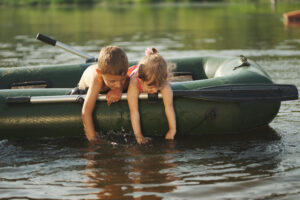Summer weather is here and vacation season is upon us! Many Virginians will head to the beach or the river to cool off, play in the sand, fish, and enjoy the Commonwealth’s many wonderful water access points.

For some, the trip may be their first time vacationing on the water or bringing children to enjoy this feature. Each body of water comes with potential hazards that deserve special attention. Allen & Allen attorneys have published several articles about beach and pool safety to address these issues.
However, there are also hidden dangers at the beach and river that can injure or kill the unsuspecting or unknowing people. Some beaches have lifeguards that will warn of these dangers. Unfortunately, many do not. Countless beaches will have “don’t swim” recommendations that are not enforced. Rivers usually don’t have many life-guarded spots and don’t seem to command the same attention or respect as the ocean, though they can be equally if not more dangerous than the ocean.
What is a rip current?
A rip current occurs in bodies of water with breaking waves, such as the beach. They are channels of water that flow at a faster pace than the surrounding area. A rip current can pull a swimmer hundreds of yards out into the ocean at speeds of up to 8 feet a second, which is faster than an Olympic swimmer. The rip current can also exhaust a beach goer to the point of drowning. Most people don’t know how dangerous rip currents can be, even in just three feet of water. In fact, more than 100 people are killed each year by rip currents.
Do rivers have rip tides?
A rip tide is a specific type of current, associated with swift movement of tidal water through inlets and the mouths of rivers and harbors. The severity of river currents and rip tides can’t be safely measured simply by looking at them. The severity can often increase with wind speed or recent rainfall.
Rip tides and river currents can be so strong that they claim the lives of even the strongest swimmers and professional rescuers. In fact, 90 people have drowned in the seemingly lazy Rappahannock River in Fredericksburg since 1970, when drownings started being tracked.
Look out for and stay away from Virginia’s low-head dams. There are 59 of them in the Commonwealth and they are extremely dangerous. They are often found in slow moving, calm-looking water but their danger to swimmers cannot be overstated; they have been called “drowning-machines.”
What type of injuries can result from swimming in a river?
Rivers also pose additional dangers to those that jump into them. River depths can change drastically and quickly in certain areas. It is almost impossible to gauge river depth with sight. Some of the dangers include:
- Spinal injuries, from jumping into rivers headfirst without knowing the depth of the river
- Spinal or other orthopedic injuries, from jumping into the same spot they always have, not knowing that the area has had changed depths or had a tree or obstruction deposited
- Shocking the body to the point of drowning when jumping into a cold river on a hot day.

Water safety tips
To be safe near bodies of water this summer, be sure to practice the following.
- Don’t swim alone.
- Pick a beach or a river protected by a lifeguard, and ask the lifeguard about ocean or river conditions.
- If no guarded spot is available, bring a friend who is a strong swimmer or use an approved floatation device.
- Children need supervision near water. A child can drown in less than 60 seconds, so pay special and constant attention to them.
- The National Weather Service (and most beach info websites) publishes daily advisories and warnings. It is best practice to review the rip current forecast and follow the National Weather Service recommendations to not swim in high-risk
- If you do get caught in a rip current, relax, it won’t pull you under. Swim in a direction parallel to the shoreline, and you can swim out of it. If you can’t, conserve your energy and make noise.
- Don’t swim in a river with visible rapids or “white water.” These are indicators of fast river currents, which are dangerous for swimming.
- If you can see the bottom of a river, don’t jump in. It is too shallow.
- If you can’t see the bottom of the river, assume that it is too dangerous to jump in. The river could be shallow or could have submerged dangers such as rocks, trees or debris. Slowly enter the water to test the area and depth.
- If you encounter a swimmer in distress or drowning, don’t attempt a “contact rescue,” except as a last resort. Throw the victim a floating device with a rope attached or reach to the victim with whatever you have available (a fishing pole for example). Drowning victims often drown the untrained rescuer as well.
Summer is the season to unwind, and studies have proven that time spent near water is a big boost to mental health. If you are enjoying the water safely, it will be a great time had by all.
If you or a loved one has been injured in a water-related accident through no fault of your own, you may be entitled to compensation. Call the personal injury attorneys at Allen & Allen today for a free case evaluation, at 866-388-1307.





